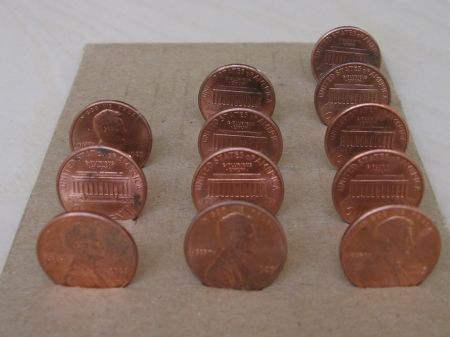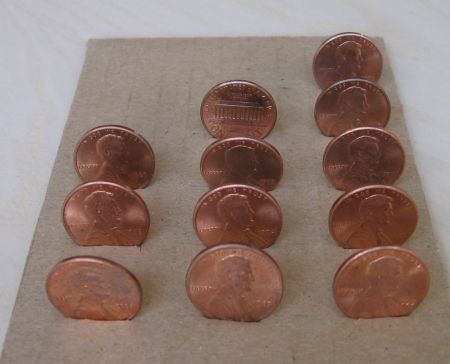Do you have twelve coins handy? You can lay them out on a piece of cardboard to keep track of the month, day, and day of the week, as shown here at Evil Mad Scientist Laboratories. Here’s the one I made:

Think of each penny as one bit, with heads meaning 1 and tails meaning 0. Each column is read as a binary number, from top to bottom.
The image shows Thursday, January 1st. Here’s how to interpret it:
- Left column: Day of the week. The days of the week are numbered 1 through 7, indicating Sunday through Saturday. The day of the week is 101, which is 5, so it’s Thursday.
- Middle column: Month. The months are numbered 1 through 12, indicating January through December. The month is 0001, or 1, so it’s January.
- Right column: Day. The days are numbered 1 through 31, indicating the 1st through the 31st. The day is 00001, or 1, so it’s the 1st.
Just to make sure you get it, here’s what Saturday, July 31st would look like:


When I swim, I count both my laps as well as the number of strokes per lap.
I try to do a mile in the neighborhood of 30 minutes, with early 25 meter laps
taking about 7 complete strokes (both arms) and never expanding beyond 9 complete strokes. It’s important to count strokes and laps, but it gets boring. To make it more interesting, I’ve also been thinking about how I might go about
counting on my fingers and toes. If you take each digit and think of it extended as having a “1” present in its position, and curling under to represent a “0”, you have 20 positions, which permits representation up to (2**23)-1,
which lets yo count beyond a million just using your fingers and toes – right?
Hint: use your fingers for the least significant bits as they change the most.
Jesse,
Yes, 2^20 – 1 = 1,048,575 positions.
I’ve tried counting in binary on one hand but it’s kind of hard to do without getting help from the other hand (to keep the bits either up or down and not “indeterminate”). Two hands would be hard. Forget two feet too!
There’s lots written about binary finger counting. Here’s one video showing counting to 31 on one hand: http://www.youtube.com/watch?v=z8p-tLD5E5A“. It uses “negative logic” though — I prefer finger up = 1, finger down = 0.